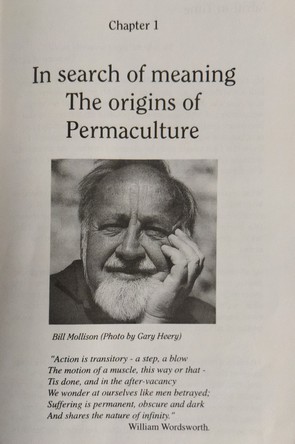
Travels in Dreams
5 August, 2020
Chapter 1 Who are you, who am I?
12 August, 2020Chapter 1
In search of meaning
The origins of
Permaculture
“Action is transitory – a step, a blow
The motion of a muscle, this way or that –
Tis done, and in the after-vacancy
We wonder at ourselves like men betrayed;
Suffering is permanent, obscure and dark
And shares the nature of infinity.”
William Wordsworth
Adrift in Time
‘He who hesitates is mostly saved.’
Groucho Marx
My father never wearied of telling me stories of his life – but very little about the war, just glimpses – or of his peaceful adventures in rural Australia. He never tired of stories, and many of his stories were dreams of what was possible, possible adventures, possible inventions, possible ways to produce excellent and healthy products, possible ways to employ people (it was the depression). I know that I got caught up in his dreams; I continue the dreams of a dreamer. And, in the end, every one of us is alone, except for those who dream our dreams.
What is possible to us, is not to destroy opportunities for others; to build soils, to create humus, save floodwater, and in general to conserve and enhance resources; including the educational resource (the information resource) of others, who will need our land if they are to survive, and who can build on our information, and our errors.
At all times, I have felt myself outside, an outsider. If I see people rushing somewhere, I turn at right angles to their path, I know that everybody is usually wrong, or usually the victim of mass persuasion, conformity, infectious plague. So lemmings press into the river, mammoths stampede over cliffs, locusts drop into the ocean, bodies of all sorts pile up in death.
I think that anybody who daydreams is an outsider; they are imagining worlds different from those about them; they are nowhere real. Philomena would say, “I always feel that you are looking at a distant horizon!” and it’s true; it may even be normal or essential in landscape design, and even more so in water harvesting, where many miles of acequias, canals, swales, way-dams, and spill-ways can be built, between intake and tail drain, but every one has to be planned to fall along a line; falling not much more than 12cm per kilometre.
When we design, we are always building for future floods, future fires, future droughts. And planting a tree a few cm. tall that will be future forest giants, throw future shadows. Future populations will need future soils and forest resources, shelter, security. So somebody needs to range ahead in time, scout out the next century. We are not day-dreaming; we are time scouts, finding places now for what will be needed then. All this must be imagined or pictured, not on a screen, but in our mind. We must watch distant horizons and adjust our courses in terms of distant signals, hints carried on the winds.
“What do you think you are doing here?” “I don’t know, but I will one day see how it turns out!” Nobody knows what they do, how it will turn out; nothing is forever, and priorities change; needs change, even the hills change. “What will you talk about?” they ask. I don’t know, but I will try to paint landscapes in their minds, throw pictures on the clouds of tomorrow’s sky. For a social animal, foreseeing future peoples, it is normal to daydream; why else would a bee gather honey, and seal it in a wax cell? And if we succeed, then a sustainable system is self-governing, so when they say, “What are you doing?” we can truthfully say “Nothing.”
I have noticed, in myself or others, that we never want to do anything we have done too often or too much. So I have slept hard too much, travelled the world too much, seen too many people. The German word for it is Weltschmerz, or world-weariness.
I never quite know what I’m doing, because I never know exactly how it will turn out; things I did as a young man, I would not do now, clearing forests for dairy, snaring wallabies for fur alone; it could be that I may myself change, or the ethics of land use may change, as much in the future as the past. Besides, everything I do now is in a real sense, experimental; it is done to see if it will work well, or not at all, and also because it appears to be harmless or beneficial at the time.
In the long term, we need to devise sustainable living systems, therefore we need models; in the very long term, we will perish as a species, but I see no morality in taking other species with us, or sending them to early extinction. They may be needed by a future world, of which we have no part.
Thus, if people come into my garden, and ask what I am doing, I must answer that I don’t know, I really don’t know. Though I plan as carefully as I can, and although I believe in doing trials, I still don’t know how it will all end, nor how it will self-evolve. But I notice that there is less to do every year.
So we proceed form generation to generation, doing what we believe to be our best, while knowing that our best will not be our children’s best, nor will it be the best thing we know about the next decade; we do things in order to trial, improve, and test them over the long term.
 .
.